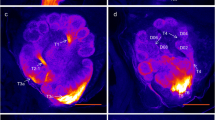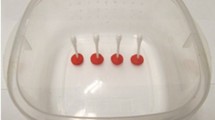Abstract
The honeybee is an excellent model organism for research on learning and memory among invertebrates. Learning and memory in honeybees has intrigued neuroscientists and entomologists in the last few decades, but attention has focused almost solely on the Western honeybee, Apis mellifera. In contrast, there have been few studies on learning and memory in the Eastern honeybee, Apis cerana. Here we report comparative behavioral data of color and grating learning and memory for A. cerana and A. mellifera in China, gathered using a Y-maze apparatus. We show for the first time that the learning and memory performance of A. cerana is significantly better on both color and grating patterns than that of A. mellifera. This study provides the first evidence of a learning and memory difference between A. cerana and A. mellifera under controlled conditions, and it is an important basis for the further study of the mechanism of learning and memory in honeybees.






Similar content being viewed by others
Abbreviations
- A. mellifera :
-
Apis mellifera
- A. cerana :
-
Apis cerana
- CCD:
-
Colony collapse disorder
References
Avargues-Weber A, Dyer AG, Giurfa M (2011) Conceptualization of above and below relationships by an insect. Proc R Soc Lond Ser B 278:898–905
Avargues-Weber A, Dyer AG, Combe M, Giurfa M (2012) Simultaneous mastering of two abstract concepts by the miniature brain of bees. Proc Natl Acad Sci 109:7481–7486
Baird E, Srinivasan M, Zhang S, Cowling A (2005) Visual control of flight speed in honeybees. J Exp Biol 208:3895
Butler CG (1975) The honey bee colony-life history. In: The Hive and the Honey Bee. Dadant and Sons, Hamilton, pp 39–74
Chandra BCS, Geetha L, Abraham VA, Karanth P, Thomas K, Srinivasan MV, Gadagkar R (1998) Uniform discrimination of pattern orientation by honeybees. Anim Behav 56:1391–1398
Chen S (2001) The apicultural science in China. China Agriculture Press, Beijing
Chen L, Zhang S, Srinivasan M (2003) Global perception in small brains: topological pattern recognition in honey bees. Proc Natl Acad Sci 100:6884
Cheng W, Zhou C, Chai H, Zhao S, Li B (2009) Quantitative extraction and analysis of basic morphological types of land geomorphology in China. J Geo-Inf Sci 6:725–736
Chittka L, Vorobyev M, Shmida A, Menzel R (1993) Bee color vision—the optimal system for the discrimination of flower colours with three spectral photoreceptor types? In: Wiese K (ed) Sensory systems of Arthropods. Springer-Verlag, New York, pp 211–218
Chittka L, Dyer AG, Bock F, Dornhaus A (2003) Psychophysics: bees trade off foraging speed for accuracy. Nature 424:388
Collett TS, Graham P, Durier V (2003) Route learning by insects. Curr Opin Neurobiol 13:718–725
De Ibarra NH, Vorobyev M, Brandt R, Giurfa M (2000) Detection of bright and dim colours by honeybees. J Exp Biol 203:3289–3298
Dietz A, Krell R, Pettis J (1986) The potential limit of survival for Africanized bees in the United States. In: Proceeding of the Africanized Honey Bee Symposium, American Farm Bureau Research Foundation, Atlanta, GA, Feb 11–12, pp 87–100
Evans JD, Saegerman C, Mullin C, Haubruge E, Nguyen BK, Frazier M, Frazier J, Cox-Foster D, Chen Y, Underwood R (2009) Colony collapse disorder: a descriptive study. PLoS ONE 4:e6481
Fan Y, Zhou M (2005) World Atlas. China Map Press, Beijing
Giurfa M (2004) Conditioning procedure and color discrimination in the honeybee Apis mellifera. Naturwissenschaften 91:228–231
Giurfa M (2007) Behavioral and neural analysis of associative learning in the honeybee: a taste from the magic well. J Comp Physiol A 193:801–824
Giurfa M, Eichmann B, Menzel R (1996) Symmetry perception in an insect. Nature 382:458–461
Giurfa M, Vorobyev M, Brandt R, Posner B, Menzel R (1997) Discrimination of coloured stimuli by honeybees: alternative use of achromatic and chromatic signals. J Comp Physiol A 180:235–243
Giurfa M, Zhang S, Jenett A, Menzel R, Srinivasan MV (2001) The concepts of ‘sameness’ and ‘difference’ in an insect. Nature 410:930–932
Gong Y, Zhang Q (2000) Classification and evolution of honeybee. Fujian science and technology press, Fuzhou
Gross HJ, Pahl M, Si A, Zhu H, Tautz J, Zhang S (2009) Number-based visual generalisation in the honeybee. PLoS ONE 4:e4263
Hateren JH, Srinivasan M, Wait P (1990) Pattern recognition in bees: orientation discrimination. J Comp Physiol A 167:649–654
Lean G, Shawcross H (2007) Are mobile phones wiping out our bees? News, The Independent [online]. http://newsindependentcouk/environment/wildlife/article2449968ece
Li B, Pan B, Han J (2008) Basic terrestrial geomorphological types in China and their circumscriptions. Quat Sci 28:535–543
Louveaux J (1969) Ecotype in honey bees. Pro. Int Beekeep Congr Munich 22:499–501
McCabe S, Farina W (2009) Odor information transfer in the stingless bee Melipona quadrifasciata: effect of in-hive experiences on classical conditioning of proboscis extension. J Comp Physiol A 195:113–122
McCabe S, Farina W (2010) Olfactory learning in the stingless bee Tetragonisca angustula (Hymenoptera, Apidae, Meliponini). J Comp Physiol A 196:481–490
McCabe S, Hartfelder K, Santana W, Farina W (2007) Odor discrimination in classical conditioning of proboscis extension in two stingless bee species in comparison to Africanized honeybees. J Comp Physiol A 193:1089–1099
Menzel R (1967) Untersuchungen zum Erlernen von Spektralfarben durch die Honigbiene (Apis mellifica). J Comp Physiol A 56:22–62
Menzel R (1968) Das Gedaechtnis der Honigbiene fuer Spektralfarben I.Kurzzeitiges und langzeitiges Behalten. J Comp Physiol A 60:82–102
Menzel R (1990) Learning, memory, and “cognition” in honey bees. In: Kesner RP, Olton DS (eds) Neurobiology of comparative cognition. Lawrence Erlbaum Associated, Hillsdale, pp 237–292
Menzel R (2001) Searching for the memory trace in a mini-brain, the honeybee. Learn Mem 8:53–62
Menzel R, Geiger K, Chittka L, Joerges J, Kunze J, Uuml U (1996) The knowledge base of bee navigation. J Exp Biol 199:141–146
Oldroyd BP (2007) What’s killing American honey bees? PLoS Biol 5:e168
Pahl M, Zhu H, Pix W, Tautz J, Zhang S (2007) Circadian timed episodic-like memory—a bee knows what to do when, and also where. J Exp Biol 210:3559
Pahl M, Zhu H, Tautz J, Zhang S (2011) Large scale homing in honeybees. PLoS ONE 6:e19669
Ruttner F (1975) Races of bees. In: The Hive and the Honey Bee. Dadant and Sons, Hamilton, pp 19–38
Srinivasan M, Lehrer M (1988) Spatial acuity of honeybee vision and its spectral properties. J Comp Physiol A 162:159–172
Srinivasan M, Zhang S, Witney K (1994) Visual discrimination of pattern orientation by honeybees: performance and implications for cortical’ processing. Proc R Soc Lond Ser B 343:199–210
Su S, Cai F, Si A, Zhang S, Tautz J, Chen S (2008) East Learns from West: asiatic honeybees can understand dance language of European honeybees. PLoS ONE 3:e2365
van Engelsdorp D, Underwood R, Caron D, Hayes J Jr (2007) An estimate of managed colony losses in the winter of 2006–2007: a report commissioned by the apiary inspectors of America. Am Bee J 147:599–603
Vorobyev M, Menzel R (1999) Flower advertisement for invertebrates: bees. In: Acher SN et al (eds) The Ecology of Vision. Kluwer Academic Publishers, Dordrecht, pp 537–553
Zeng Z (2009) Apiculture. China Agriculture Press, Beijing
Zeng Y, Zeng Z, Yan W, Wu X (2010) Effects of three aliphatic esters of brood pheromone on worker feeding and capping behavior and queen development of A. cerana cerana and A. mellifera ligustica. Acta Entomol Sin 53:154–159
Zhang S, Srinivasan M (1994) Prior experience enhances pattern discrimination in insect vision. Nature 368:330–332
Zhang S, Srinivasan M, Horridge G (1992) Pattern recognition in honeybees: local and global analysis. Proc R Soc Lond Ser B 248:55
Zhang S, Srinivasan M, Collett T (1995) Convergent processing in honeybee vision: multiple channels for the recognition of shape. Proc Natl Acad Sci 92:3029
Zhang S, Bartsch K, Srinivasan M (1996) Maze learning by honeybees. Neurobiol Learn Mem 66:267–282
Zhang S, Lehrer M, Srinivasan M (1999) Honeybee memory: navigation by associative grouping and recall of visual stimuli. Neurobiol Learn Mem 72:180–201
Zhang S, Mizutani A, Srinivasan M (2000) Maze navigation by honeybees: learning path regularity. Learn Memory 7:364–374
Zhang S, Srinivasan M, Zhu H, Wong J (2004) Grouping of visual objects by honeybees. J Exp Biol 207:3289
Zhang S, Bock F, Si A, Tautz J, Srinivasan M (2005) Visual working memory in decision making by honey bees. Proc Natl Acad Sci 102:5250
Zhang S, Schwarz S, Pahl M, Zhu H, Tautz J (2006) Honeybee memory: a honeybee knows what to do and when. J Exp Biol 209:4420
Acknowledgments
We thank Hong Zhu for invaluable guidance and assistance with all of the experiments, Fei Zhang and Junfeng Liu for help with beekeeping, Jianjin Zeng for constructing the maze apparatus, Haiyan Gan and Xu Han for help with behavioral experiments, Dr. Aung Si and Dr. Zilong Wang for helpful suggestions that improved the manuscript, and theCenter of Analysis and Measurement of Zhejiang University for measuring the spectra of color patterns. This work was supported by the Earmarked Fund for the China Agricultural Research System (no. CARS-45-KXJ12) and the National Natural Science Foundation of China (no. 31060327).
Author information
Authors and Affiliations
Corresponding authors
Rights and permissions
About this article
Cite this article
Qin, QH., He, XJ., Tian, LQ. et al. Comparison of learning and memory of Apis cerana and Apis mellifera . J Comp Physiol A 198, 777–786 (2012). https://doi.org/10.1007/s00359-012-0747-9
Received:
Revised:
Accepted:
Published:
Issue Date:
DOI: https://doi.org/10.1007/s00359-012-0747-9




